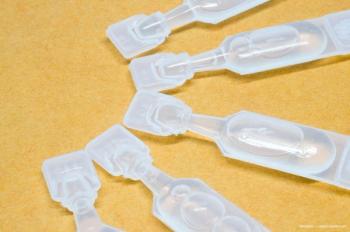
Scleral tunnel ‘glued’ fixation technique for slipped IOLs
Scleral tunnel, “glued” fixation technique works better than alternative fixation techniques in cases where intraocular lenses (IOLs) cannot be placed in capsular bag or in the sulcus, according to Sumit Garg, MD.
Reviewed by Sumit Garg, MD
Scleral tunnel, “glued” fixation technique works better than alternative fixation techniques in cases where intraocular lenses (IOLs) cannot be placed in capsular bag or in the sulcus, according to Sumit Garg, MD.
“It’s easier than suture fixation because you don’t have to deal with the spaghetti of the sutures and it will turn out to be more stable long-term,” said Dr. Garg, associate professor of ophthalmology, University of California, Irvine.
(Figure 1) Externalized haptics. (Images courtesy of Sumit Garg, MD)
Popularized by Amar Agarwal, FRCOphth, Chennai, India, scleral tunnel fixation avoids the problem of long-term suture degradation, provides good short-term stability through the use of tissue glue, and creates long-term stability through compression of the haptics.
Running through the alternatives, Dr. Garg said iris fixation offers the advantages of avoiding scleral or conjunctival surgery, a small, self-sealing incision, and a foldable IOLs with small-incision insertions. But iris fixation requires normal iris anatomy and can chafe the iris, causing pupil ovaling, pseudophakodonesis, and/or increased risk of cystoid macular edema, he added.
Technique provides separation
Suturing the IOL to the sulcus provides the maximum separation from sensitive iris tissue and the corneal endothelium. There is no angle or trabecular involvement and no distortion of the pupil.
But scleral suturing is time consuming and demanding, and it can require a large incision. Potential suture exposure can lead to endophthalmitis, and late suture breakage can lead to IOL dislocation, said Dr. Garg.
(Figure 2) Creation of scleral tunnel with 27-gauge needle.
He cited a recent study of 82 patients with scleral sutures. In a mean follow-up time of 83 months, 30.5% had ocular hypertension, 6.1% had suture breakage, 11% had suture exposure, 4.9% had retinal detachment (RD), 7.3% had cystoid macular edema (CME), and 3.17% had persistent elevated intraocular pressure (IOP).
“There have been a number of studies showing that sutures last 7-10 years and then have a higher chance of breaking,” said Dr. Garg. “In a 40- to 50-year-old patient, you’re pretty much assuring they’re going to need another surgery. If you’re not depending on the longevity of the suture, you have a better chance of a once-and-done surgery.”
The keys to Dr. Garg’s acceptance of scleral tunnel fixation are the low rate of complications and the tunnel, not the glue, that are responsible for long-term stability. He added that studies with high-speed videography have shown that unlike iris- and scleral-sutured IOLs, scleral-tunnel IOLs have minimal phacodonesis.
Good candidates
Patients who are aphakic and no longer tolerate contact lenses are good candidates, as are other patients who are at risk of lens dislocation. Dr. Garg has found the technique effective in patients who do not have normal capsules. “It’s really meant for when there is a lack of bag or sulcus fixation,” he added.
But scleral tunnel fixation isn’t perfect. “It’s not without its complications long term,” said Dr. Garg. The procedure is technically challenging, requires special instrumentation, and will not work in every eye.
A current or future bleb, previous surgery, a thin sclera, or insufficient vitrectomy can pose significant problems.
“Any procedure where you have disrupted the anterior hyaloid face, you have to be careful to do as complete a vitrectomy as possible,” Dr. Garg said. “You don’t want traction on the vitreous to cause cystoids macular edema and risk of infection.”
He also advised caution in conjunctivas with extensive scarring. “If the conjunctiva is scarred down, this procedure becomes more difficult because the conjunctiva has to be lifted up,” said Dr. Garg. “If someone has really scarred down, that’s where an alternative may be the better choice.”
Other relative contraindications include corneal decompensation or atrophic scleromalacia. “Make sure the sclera is healthy and you have enough to tunnel the haptic in,” Dr. Garg advised. “We are limited by the length of the haptics, so you have to make sure it’s not a huge eye.”
Agarwal study
Dr. Agarwal and colleagues followed 208 eyes in 185 patients for 17 months and recorded a low incidence of complications. Early on, 6% had corneal edema, 2% had epithelial defects, and 2.5% had grade 2 anterior chamber reactions. Later, 0.4% had hyphema, 0.4% of haptics broke, and 1% of haptics were deformed.
Another 4.3% had optic capture, 3.3% IOL decentration, 2% haptic extrusion, 1.4% subconjunctival haptics, 2% macular edema, and 2% pigment dispersion. Re-operation was required in 7.7% of patients.
Best corrected visual acuity (BCVA) was 20/40 or better in 40% of this group and 20/60 or better in 49%.
In a second cohort of 60 eyes with a follow-up of 5 years, Dr. Agarwal and colleagues reported that 35% had optic tilt of roughly 3º between the IOL and the iris. The mean residual cylinder was 0.5 D (±0.5 D). There was no correlation with BCVA.
“We don’t have really long-term data on the technique,” said Dr. Garg. “You can get migration of the haptics out of the tunnel, which on occasion has to be retunneled, or a patch graft has to be placed to make sure it doesn’t extrude through the conjunctiva. But by and large, it’s a really stable method of fixation.”
He described a recent case of an IOL that stayed intact even though the penetrating keratoplasty wound dehisced after a patient bumped his eye against the ledge of a table. “The scleral fixation of the haptics actually prevented dislocation of the IOL,” said Dr. Garg.
Procedure points
Scleral tunnel fixation is easiest done with an assistant and it requires coaxial micro instruments, including a micro forceps for the anterior segment, an anterior chamber maintainer, and fibrin glue.
The procedure will not work with every IOL, Dr. Garg added. “You want something with a relatively resistant haptic, something that can be bent and maintains its shape,” he said.
He recommended the Aaren EC-3 PAL (acrylic optic, polyvinylidene fluoride haptic) IOL (Zeiss Meditec).
Dr. Garg advised making sure the haptics are 180º apart. Grab the haptic during insertion and try not to lose it once it’s externalized. The sclerostomy should only be about 23-gauge, he said. Dr. Garg uses a scleral scale ruler.
(Figure 3) End of case: Well-centered, glued IOL.
In the case of a large, white-to-white measurement, he recommended orienting the haptics vertically.
“Even though this is called a ‘glued’ IOL, it’s not really glued long-term,” Dr. Garg explained. “The glue is meant for initial fixation and healing. The fixation is because of the haptic in the scleral tunnel. The glue will dissolve over the first week to two. You could do it without glue if you have to. I use a vicryl suture to fixate the haptic just to provide short-term fixation while the haptic secures itself long-term.”
Sumit Garg, MD
This article is based on a presentation that Dr. Garg delivered at 2017 American Society of Cataract and Refractive Surgery (ASCRS) annual meeting.
Newsletter
Don’t miss out—get Ophthalmology Times updates on the latest clinical advancements and expert interviews, straight to your inbox.



















































.png)


